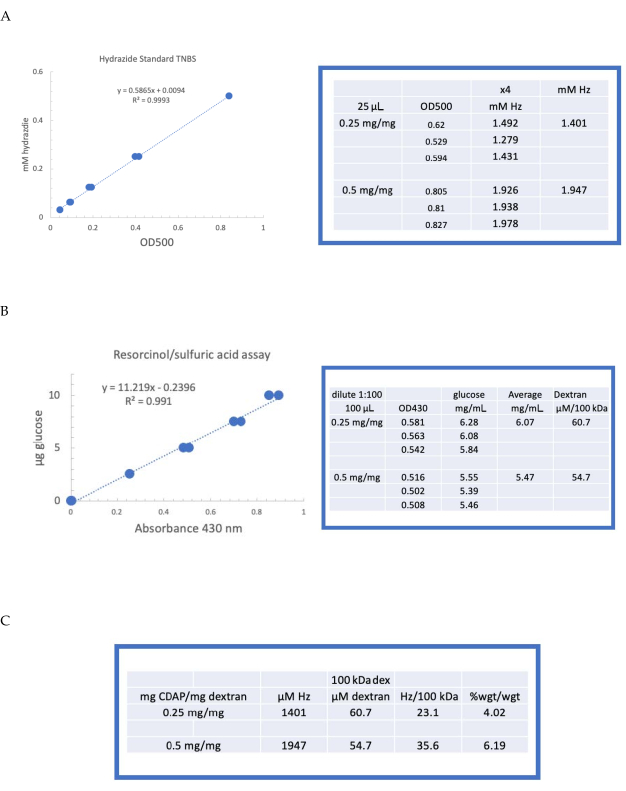Abstract
Immunology and Infection
הפעלה והטיאה של פוליסכרידים מסיסים באמצעות 1-Cyano-4-דימתילאמינופירידין טטרפלואורובוראט (CDAP)
ERRATUM NOTICE
Important: There has been an erratum issued for this article. Read more …חיסונים מצומדים הם התקדמות יוצאת דופן בחיסון. להכנת חיסונים מצומדים פוליסכריד, ניתן לתפקד בנוחות את הפוליסכרידים ולקשר אותם לחלבונים נושאי חיסונים באמצעות 1-ציאנו-4-דימתילאמינופירידאין טטרפלואורובוראט (CDAP), ריאגנט ציאנילציה קל לטיפול. CDAP מפעיל פוליסכרידים על ידי תגובה עם קבוצות הידרוקסיל פחמימות ב pH 7-9. היציבות והתגובה של CDAP תלויות מאוד ב- pH. ה- pH של התגובה גם פוחת במהלך ההפעלה עקב הידרוליזה של CDAP, מה שהופך את השליטה הטובה ב- pH למפתח להפעלה ניתנת לשחזור. פרוטוקול ההפעלה המקורי של CDAP בוצע בטמפרטורת החדר בפתרונות pH 9 לא מכוסים.
בשל התגובה המהירה במצב זה (<3 דקות) וצניחת ה- pH המהירה הנלווית מההידרוליזה המהירה של CDAP, היה מאתגר להתאים במהירות ולשמור על ה- pH של תגובת היעד במסגרת הזמן הקצרה. הפרוטוקול המשופר המתואר כאן מבוצע ב 0 °C (50 °F), אשר מאט הידרוליזה CDAP ומאריך את זמן ההפעלה מ 3 דקות כדי ~ 15 דקות. Dimethylaminopyridine (DMAP) שימש גם כחוצץ להתאמה מראש של פתרון הפוליסכריד ל- pH של הפעלת היעד לפני הוספת ריאגנט CDAP. זמן התגובה הארוך יותר, יחד עם הידרוליזה CDAP איטית יותר ושימוש במאגר DMAP, מקל על שמירה על pH ההפעלה במשך כל תהליך ההפעלה. הפרוטוקול המשופר הופך את תהליך ההפעלה לפחות תזזיתי, לניתן לשחזור יותר וניתן יותר לשינוי קנה מידה.
Erratum
Erratum: Activation and Conjugation of Soluble Polysaccharides using 1-Cyano-4-Dimethylaminopyridine Tetrafluoroborate (CDAP)An erratum was issued for: Activation and Conjugation of Soluble Polysaccharides using 1-Cyano-4-Dimethylaminopyridine Tetrafluoroborate (CDAP). A figure was updated.
Figure 4 was updated from:

Figure 4: Representative results for CDAP activation of dextran. Typical standard curves for the (A) resorcinol/sulfuric acid and (B) TNBS assays. The assay results for dextran activated with 0.25 and 0.5 mg CDAP/mg dextran are shown. Glucose was used as the standard for the resorcinol assay. Dextran, in mg/mL, is divided by 100 kDa to give a molar concentration. The hydrazide concentration is determined using ADH as the standard and the results expressed as µM Hz. (C) Calculation of hydrazide: dextran ratios.The level of derivatization was calculated as hydrazides per 100 kDa of dextran to facilitate the comparison between polymers of different average molecular weights. The % weight ratio of g ADH/g dextran was calculated using a MW of 174 g/mole for ADH. Please click here to view a larger version of this figure.
to:

Figure 4: Representative results for CDAP activation of dextran. Typical standard curves for the (A) resorcinol/sulfuric acid and (B) TNBS assays. The assay results for dextran activated with 0.25 and 0.5 mg CDAP/mg dextran are shown. Glucose was used as the standard for the resorcinol assay. Dextran, in mg/mL, is divided by 100 kDa to give a molar concentration. The hydrazide concentration is determined using ADH as the standard and the results expressed as µM Hz. (C) Calculation of hydrazide: dextran ratios.The level of derivatization was calculated as hydrazides per 100 kDa of dextran to facilitate the comparison between polymers of different average molecular weights. The % weight ratio of g ADH/g dextran was calculated using a MW of 174 g/mole for ADH. Please click here to view a larger version of this figure.
Tags
ABOUT JoVE
Copyright © 2024 MyJoVE Corporation. All rights reserved